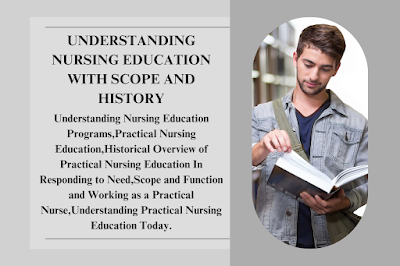Understanding To Nursing Educational Programs
Introduction
This topic based on discussion of the levels of nursing education prevalent since the turn of the 20th century and the issues associated with each program. The discussion begins with practical nursing, the most basic level of nursing education, and progresses to describing more advanced nursing education. programs. Secondly focuses on curriculum and instruction in nursing education, beginning with a description of curriculum and instruction and including exemplars that describe what students learn and how they learn it in today's nursing schools.
One might wonder why it is important for nursing students to understand curriculum and instruction. In the past, what and how students learned was the specialty of faculty. However, recent evidence suggests that student-centered curriculum and instruction can improve learning outcomes (Candela, Dalley, & Benzel Lindley, 2006).
As faculty respond to this trend, they seek approaches that overcome learning environments where teaching and learning as well as the teacher and the learner are separate, discrete, polarizing entities, each with his or her own predetermined roles, functions, and expected responsibilities.This means that students play an increasingly active role in their own learning.
Therefore, a goal of the latter part of this chapter is to promote dialogue between teachers and students to encourage mutual trust, respect, and understanding for the content and processes involved in the preparation of nursing students for contemporary nursing practice.
Students and teachers are encouraged to use this chapter as a platform for discussion, which can be further enriched by exploring the reference list provided at the end of the chapter. Provides an excellent gateway to engage readers in the study of nursing education and to pursue ways of integrating its content with other sources of knowledge.
Understanding Nursing Education Programs
To gain an understanding of the various nursing education programs and the context within which they were developed, the discussion for each program includes a historical account of the program's development, the unique and significant issues and challenges associated with the program, and information on contemporary trends related to the program.
This approach provides a comprehensive overview that captures the essence of
available avenues to achieving a nursing degree. A description of mobility
programs and a discussion of the educational accreditation process and its
important role in ensuring high quality nursing education programs are also
included.
Practical Nursing Education
“Unlike the historically untrained or poorly trained practical
nurse, who had unlimited and unsupervised freedom to practice, the present
practical nurse is often a hybrid. Today's practical/vocational nursing student
is being taught basic skills during the educational program. After licensing,
the LPN/LVN [practical nurse] is permitted to perform complex nursing, as
delegated by the registered nurse and allowed by the nurse practice act” (Hill
& Howlett, 2005, p. 80).
Historical Overview of Practical Nursing Education In Responding to Need
Practical nursing, the most basic level of nursing practice, began with the industrial revolution of the late 1800s. To meet labor workforce demands during this time, many people moved from rural areas to urban areas. Women needing employment often provided domestic services, including those associated with caring for the sick (Kurzen, 2005).
To support the skills of this new healthcare provider, in 1892 the Young
Women's Christian Association (YWCA) located in Brooklyn, New York, offered the
first formal practical nursing course. Over time, landmark reports about the
state of nursing education contributed to the development of practical nursing
programs. For example, in 1923 Josephine Goldmark compiled a report titled Nursing and Nursing Education in the United States.
In it she recommended higher education
standards for practical nurses, laws regulating their practice, and improved
environments for their training. In 1948 Lucille Brown compiled another report,
Nursing for the Future, which hastened the growth of practical nursing programs
by emphasizing vocational schools as good environments for practical nursing
programs. Today most practical nursing programs are in vocational schools.
Scope and Function and Working as a Practical Nurse
Since the first half of the 20th century, the scope and function of practical nurses have become increasingly sophisticated. They are licensed to practice either as licensed practical nurses (LPNs) or as licensed vocational nurses (LVNs), and they work under the supervision of registered nurses. Nurse practice acts for the practical nurse vary from state to state, but generally, the practical nurse is responsible for stable patients and patients with common health conditions.
They are also
responsible for collecting and reporting abnormal data, offering suggestions
for developing and changing nursing care, providing bedside care, teaching
health maintenance, and participating with the healthcare team in evaluating
nursing care (Kurzen, 2005).
Understanding Practical Nursing Education Today
The scope and function of practical nurses reflect the need for appropriate knowledge and capabilities to fulfill this supportive healthcare role (Mahan, 2005). Practical nursing education programs are often offered in community colleges. Most programs are 12 to 18 months in length, and graduates of these programs complete a state practical nursing exam prior to being employed. For some individuals, this short course of study is a stepping stone to pursuing advanced nursing education.
It also allows them to work as a practical nurse while obtaining further education. For others, practical nursing becomes a longterm career option.In either case, employment possibilities for practical nurses vary and are more plentiful in some states than in others. Long-term care facilities, clinics, hospitals, and home health care are the largest employers of practical nurses, with home health care leading the way in employment options.





Give your opinion if have any.